
'[Joint commissioning] is the process by which partners across education, health and care agree at a strategic level what is needed in an area and how they will work together to commission and deliver it. Critical to doing this well is engaging with children and young people with SEN and Disabilities and their families, and this is a key theme in the 0-25 SEND Code of Practice.'
Rochdale's definition of Commissioning:
'The means by which we secure the best value for children, young people and their
families. It is the process of translating aspiration and need, by specifying and
procuring services which deliver the best possible outcomes, reduce inequalities,
ensure high quality service provision, and make the most effective use of available
resources.
(Department of Health/Department for
Education, 2014)
'Joint commissioning should be informed by a clear assessment of local needs… The Joint Strategic Needs Assessment (JSNA) is the means by which [a Health and Well-being] Board understands and agrees the needs of all local people…'
'Health and Well-being Boards are required to develop Joint Strategic Needs Assessments and Joint Health and Well-being Strategies, to support prevention, identification, assessment and early intervention and a joined-up approach…
'The JSNA considers the needs of the local community as a whole, including specific
analysis of the needs of vulnerable groups including disabled children and young people
and those with SEN, those needing palliative care and looked
after children.
'Under section 75 of the National Health Service Act 2006, local authorities and CCGs can pool resources and delegate certain NHS and local authority health-related functions to the other partner(s) if it would lead to an improvement in the way those functions are exercised.'
(0-25 SEND Code of Practice, 2015, section 3.4, 3.22, 3.23)
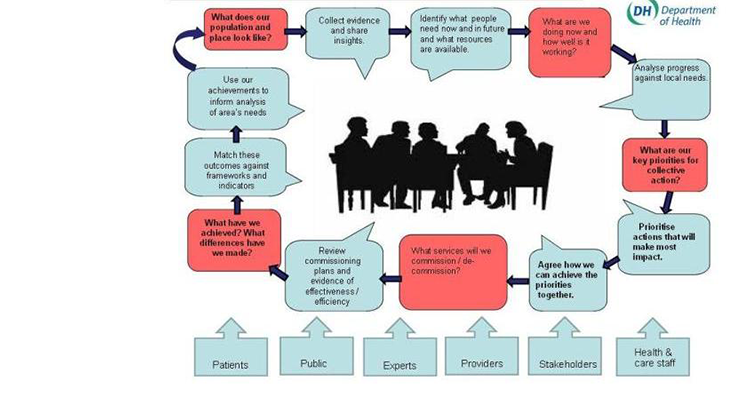
Strategic
Needs
Assessment
process

Listening and responding to the views of children/young people and their parents, and other partners are fundamental to the Joint Strategic Needs Assessment process.
Decisions are also based on an understanding of population needs gained from annual national, regional and local data, summarised in the Office of National Statistic annual publications, Special Educational Needs in England and Children with Special Educational Needs: An analysis.
Statutory tools like the school census, the local authority Child Disability Registers for children with disabilities aged 0-19 years, and the annual special educational needs survey – as well as data collected by schools for local authorities (0-25 SEND Code of Practice (2015, section 6.83) and the National Child and Maternal Health Intelligence Network – contribute to the accuracy of the overview and the effectiveness of planning for the needs of children/young people with special educational needs/disabilities and their families.
Find out about other sources (eg early years development assessment outcomes) from the 0-25 SEND Code of Practice (2015, section 3.28).

Under the Children and Families Act (Part 3), local authorities are required to
promote integration between educational and training provision with health care provision
and social care provision where they consider that this would promote the well-being
of children or young people who have special educational needs, or a disability or
where it would improve the quality of special educational provision for children/young
people with special educational needs. This is intended to assist children/young people
with educational, health and social care needs by improving the way services work
together to provide support for them.
(Children and Families Act 2014: explanatory notes, sections 178-179).
The following key legislation (among other) promotes integrated working across all three statutory agencies:
- Children Act 2004;
- National Health Service Act 2006;
- Health and Social Care Act 2012;
- Children and Families Act 2014;
- Care Act 2014.
A more comprehensive list can be found in the 0-25 SEND Code of Practice (2015, Chapter 3).

'This is an important step forward, children and young people who have a Special Education Need and/or Disability make up a significant proportion of the childhood population, with up to 20% of school age children and young people having SEN. Across this group there are a diverse range of health needs, which include children and young people with [variously] long term health conditions, …autism …sensory impairments and …mental health issues. It will also include children and young people with [variously] multiple and complex needs who may be dependent on technology, …behaviour that challenges and …a life-threatening or life-limiting condition.'
'Meeting these health needs will often require a range of different NHS services, provided by different professionals which often cut across organisational boundaries. Children with SEN and disability are therefore disproportionately disadvantaged by a system that does not integrate services, support them to make decisions about their own care or adequately support them during the transition to adult services.'
(Council for Disabled Children, 2014)
Under the Children and Families Act 2014, education, health and care services must jointly identify the outcomes that matter to the children/young people with special educational needs/disabilities and their families, and then plan, deliver and monitor service provision that is 'reasonably required'. Joint commissioning must include arrangements for:
- Securing Education, Health and Care (EHC) Needs Assessments;
- Securing the provision specified in EHC Plans;
- Agreeing Personal Budgets;
and take into account provision commissioned by other agencies, such as schools and other education settings (0-25 SEND Code of Practice, sections 3.10, 3.11, 3.18).
The Act's joint commissioning duty specifies that the local authority and its
partners must establish local governance arrangements which ensure clear ownership
and accountability across special educational needs and disability commissioning with
clarity about who is responsible for delivering what, with accountability to named
councillors and senior commissioners across education, health and social care. These
arrangements should be clear regarding who can make decisions both operationally (eg
EHC Plan provisions) and strategically (eg locally commissioned provision, exercising
statutory duties).
(Council for Disabled Children, 2014)

'Joint commissioning arrangements must cover the services for 0-25 year
old children and young people with SEN or disabilities, both with and without
EHC Plans. Services will include specialist support and therapies, such as clinical
treatments and delivery of medications, speech and language therapy, assistive technology,
personal care (or access to it), Child and Adolescent Mental Health Services (CAMHS)
support, occupational therapy, habilitation training, physiotherapy, a range of nursing
support, specialist equipment, wheelchairs and continence supplies and also emergency
provision. They could include highly specialist services needed by only a small number
of children, for instance children with severe learning disabilities or who require
services which are commissioned centrally by NHS England (for example some augmentative
and alternative communication systems, or health provision for children and young
people in the secure estate or secure colleges).' (0-25 SEND Code of Practice,
2015 (CoP), section 3.9)
The local authority must also engage other partners it thinks appropriate
to support children/young people with special educational needs/disabilities;
see
examples listed in CoP, section 3.17.
'Increasingly schools are acquiring goods and services that they have, historically,
received via different routes. The role of schools as dedicated commissioners, and
the process associated, is something that schools need to be mindful of when planning
budgets, service provision and pupil needs.'
(Cambridgeshire County Council, 2014)
The process of strategic commissioning can be summarised by the 'Understand-Plan-Do-Review' model:
Collaboration with other schools
It is likely that more than one school will share a particular service delivery.
Forming a collaborative co-commissioning group with other schools can give greater
purchase leverage than a single school and lead to better terms.
Local authorities may be able to offer advice and support for schools in commissioning
(eg around: developing service specification; the tendering process; meeting any regulatory
requirements; contract management and evaluation; and co-commissioning.
(Cambridgeshire County Council, 2014)
Understand
- Analyse and interpret data to understand what is happening for children;
- Understand the available resources – existing services – budget, property;
- Appreciate anticipated and acknowledge future developments;
- Identify needs and rank these into priorities.
Return
Plan
- Agree which priorities to tackle and in what order;
- Who will do what;
- Agree upon the available resources;
- Identify which work will need to go through a procurement process and follow the appropriate processes;
- Consider working collaboratively with other schools (commissioners) with similar requirements;
- Establish a means of measuring performance.
Return
Do
- Implement the considered plan.
Return
Review
- Monitor delivery against expected outcomes;
- Include feedback from service users.
Return
'Joint commissioning arrangements should enable partners to make best use of all
the resources available in an area to improve outcomes for children and young people
in the most efficient, effective, equitable and sustainable way (Good commissioning:
principles and practice, Commissioning Support Programme, (Rev) September 2010).'
(0-25 SEND Code of Practice, 2015, section 3.7)
Once schools and other education providers understand how the commissioning works:
- It becomes easier to work with the local authority on shared concerns and to develop relationships with key people who can support and advise in getting the best for pupils, families and school.
- It will help to build bridges with other educational settings and enable collaborative work on co-commissioning and shared concerns to identify and shape future provision.
- It will also help schools to support families/young people to get the most from the Local Offer.
For more information on commissioning, read:
Joint Commissioning for Children and Young People with SEND (In Control/South East 7, 2013)
SEND Pathfinder: Joint commissioning information pack and resources (Department of Health/Department for Education/Mott Macdonald, 2014)

Summary of Pathfinder joint commissioning 'top tips'
- Identify key individuals who can influence, make decisions and build links across services, recognising the common aim of improving outcomes of children/young people with SEND.
- Establish appropriate governance arrangements with joint representation, agreed vision, agreed outcomes and mechanisms for review.
- Identify needs, map provision, highlight gaps and agree actions across services and the population.
- Continue to develop and embed an implementation plan and be realistic about what can be achieved in the timeframes – most likely implementation will be achieved in phases
- Use effective, clear and jargon-free communications,
engaging with providers
and users from the outset.
(Department of Health/Department for Education, 2014)

Read about the roles and responsibilities of key partners within the joint commissioning arrangements in the 0-25 SEND Code of Practice (2015, section 3.70).
Find out about your local key representatives for each of these partners and any
other relevant key strategists – names, roles, responsibilities and professional education
connections. (When searching online remember to enter multi-word terms inside double
quote marks – eg 'clinical commissioning group' – to reduce irrelevant search returns).
Consider how these people may facilitate the effective access of local resources
and remove barriers to support for the children/young people with special educational
needs/disabilities and their families as well as your school's SENCO/Inclusion Manager
and their team. How can you extend/intensify/make the most of the connections in your
existing networks?
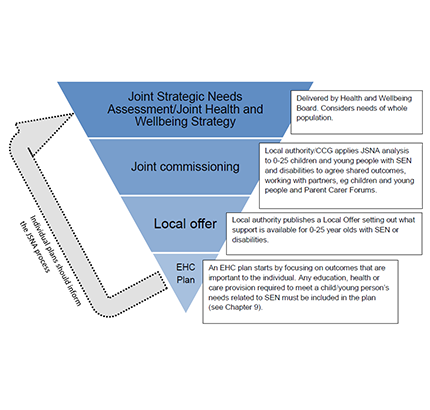
This diagram illustrates these relationships between service level commissioning and provision for children/young people with special educational needs/disabilities.
'The JSNA must be based on a comprehensive understanding of need across the local
authority, health and care systems. Joint commissioning processes must underpin the
local offer, which includes the joint offer across education, health and social care
for all children and young people with SEN both with and without an EHC Plan.'
(Communication Council, 2014)
(0-25 SEND Code of Practice, 2015, section 3.20)

Commissioning occurs at different levels to fulfil actual and anticipated needs.
In relation to education this includes:
- Clinical commissioning groups making sure the Local Offer has the capacity
to deliver necessary services; - Schools in providing 'SEN support' using their notional special educational
needs/disability budget; - Parents/young people through Personal Budgets and Direct Payments.
For example, this may be a parent, young person or school commissioning services set out in a child's/young person’s education, health and care plan; a school (or group of schools) commissioning therapy services for groups of children/young people needing 'SEN support'; a clinical commissioning group building up future services in response to local data (eg Child Disability Register; School Census outcomes; feedback from families about service short-falls).
Click here for a list of other possible commissioners.

'The goal of joint commissioning is to improve outcomes for children and young people and their families with SEN and disability. Local partners will need to develop a shared vision for children and young people with SEN and disability and their families in their area and a clear plan of what needs to be put in place to achieve this.'
Partners need:
- To develop a clear, shared understanding of these needs
and how they are currently met by education, health and
care provision; - To identify any gaps in provision that need to be addressed.
'Partners must also involve children, young people and their families in this process, they are central to the process of reviewing provision and developing shared outcomes. These outcomes should form the basis of reviewing strategic commissioning decisions and should contain measures for monitoring and evaluating progress.'
(Council for Disabled Children, 2014)
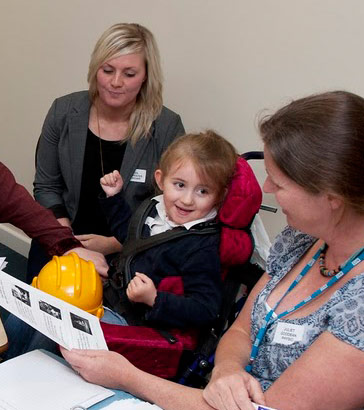
Partnerships will be established across education, health and care and with parent groups, children and young people to improve outcomes for children/young people from 0-25 years with special educational needs and/or disabilities, including those with EHC Plans.
Parents and young people can be involved in joint commissioning decisions and arrangements – some will be involved as members of decision-making groups; some in interviewing for new contracts; and others in reviews of services. Everyone can provide feedback on the content of the Local Offer.
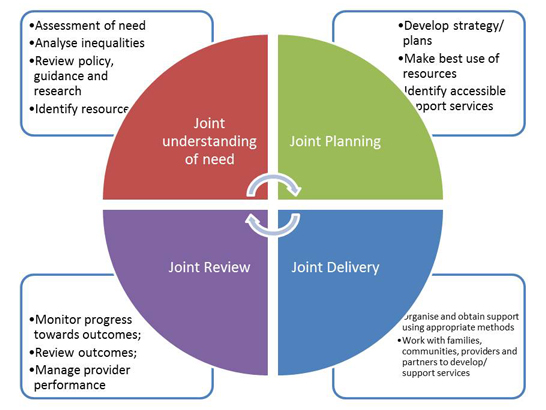
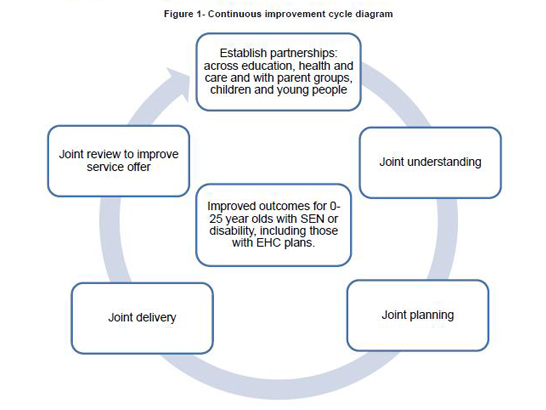
The Rochdale joint commissioning diagram shows the different tasks partners will need to collaborate on at different stages of the joint commissioning cycle.
Show diagram 1
(Department for Education/Department of Health, n.d.)
Show diagram 2
(Department for Education/Department of Health, 2015)
The local needs of children/ young people with special educational needs/disability and their families change over time, so joint commissioning partners need to keep needs, provision under review, assessing how – and if – their available provision is improving outcomes.
This process provides opportunities for innovative thinking about how they can achieve their desired outcomes most effectively and meet their own service goals through working collaboratively. (For example, see the 'NHS Mandate' (Department of Health, 2014).) Plans should make full use of the available local data and be linked to the existing Joint Strategic Needs Assessment (JSNA) carried out by the Health and Well-being Board.
Click here for examples of shared joint commissioning outcomes.
Partners must:
- Involve the views of children/young people with special educational needs/disability and their parents.
- Develop clear arrangements that set out how the partners will resolve disputes over commissioning decisions and hold each other to account for delivery of the outcomes.
The Children and Young People’s Outcomes Forum reports contain more information on the importance of outcome measures for children/young people.

The Children and Families Act 2014 builds on existing legislation and wider reforms to public services to support coordinated working, such as the Health and Social Care Act 2012, in order to improve local health and well-being and the outcomes for vulnerable children/young people.
'[O]ne area where there is a particular need for improvement, working in partnership
across different services, is in supporting children and young people with special
educational needs or disabilities.' ('NHS Mandate', Department of Health, 2014)
Local authorities and Clinical Commissioning Groups (CCGs) must ensure that:
- Procedures are in place to agree a plan of action to secure provision in line with commissioners' statutory responsibilities around the 'reasonable' needs of children/young people with special educational needs/disabilities (provision must be commissioned individually if necessary);
- Joint commissioning work outputs are presented publicly as part of the Local Offer, which should capture the range of services available relevant to children/young people with special educational needs/disability;
- The appropriate practitioners, clinicians and other professionals participate in the coordinated Education Health and Care Needs Assessment and Planning process, and review progress against agreed outcomes.
Partners will need to take account of the full range of policies that affect the provision of education, health and social care services to children/young people with special educational need/disability and how they overlap (eg Early Help Assessments, children's continuing care packages and wider 'reasonable adjustment' duties under the 2010 Equality Act).
(Department for Education/Department of Health, 2014, sections 68-73)
There are key system elements that must be in place to ensure service provision for children/young people with special educational needs/disability, including those without Education, Health and Care Plans. These include:
- Joint commissioning arrangements between the Local Authority and the relevant Clinical Commissioning Groups;
- Arrangements with NHS England for disabled children and young people and those with special educational needs who require specialist services commissioned directly by NHS England at a regional or national level.
'These joint commissioning arrangements must work to integrate educational provision and training provision with health and social care provision where [it is considered]…that this would promote the wellbeing of children and young people with SEN or disabilities or improve the quality of special educational provision.
This reinforces the existing duties on Local Authorities and health commissioners to promote the integration of services and the pools to pool budgets if this would enhance wellbeing.'
(Department for Education/Department of Health, 2014, sections 73-75)
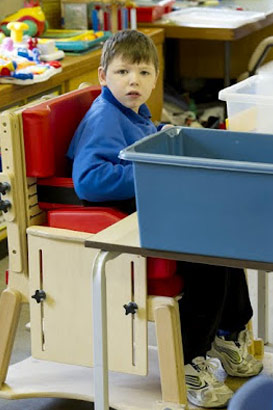
To make the best use of resources, service provider partners should consider how an integrated approach can best support the following. (Click on underlined bullet headings to reveal explanatory text.)
- Prevention;
- Early identification of needs;
- The resilience of families and local services;
- Better access to services;
- Better use of services;
- Better transitions between life stages and settings.
(0-25 SEND Code of Practice, 2015, section 3.37)
For example, using the outcomes of developmental assessments (as outlined in the Early Years Foundation Stage guidance) to target Early Help support for children experiencing developmental delay can reduce the need for specialist services later on.
Return
For example, to enable children/young people with more complex needs to participate actively in their local community.
Return
The development of good language, communication and mental health through universal services so that more effective use is made of specialist speech and language therapy services and CAMHS.
Return
and settings
Including from early years to primary education, primary to secondary and secondary to further education (FE), and children/young people in preparing for adult life.
Return
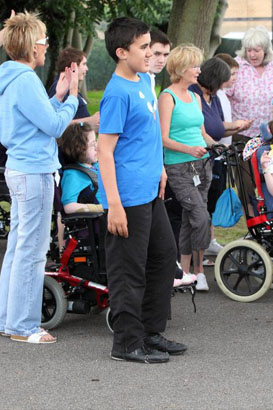
'…joint commissioning is not a new concept in Children's Services… However the requirements of the SEND reforms provide both legislation and statutory guidance to ensure that joint commissioning is delivered in practice. This is important as within the area of SLCN there remain barriers to achieving jointly commissioned service provision including:
- Establishing joint outcomes and outcome measures;
- Agreeing relative financial contributions within a joint commissioning envelope;
- Reaching a shared understanding of the provision required, both in terms of the profile of personnel delivering the provision and the nature of the activities undertaken.'
(Communication Council, 2014)

Legislation and guidance
- Children Act 2004
- National Health Service Act 2006
- Equality Act 2010
- Health and Social Care Act 2012
- Care Act 2014
- Children and Families Act 2014
- Children and Families Act 2014 (Part 3): explanatory notes
- Implementing the 0 to 25 Special Needs System: LAs and partners (Department for Education/Department of Health 2014)
- The [NHS] Mandate: A mandate from the Government to NHS England – April 2015 to March 2016. (Department of Health, 2014)
- Special Educational Needs and Disability Code of Practice: 0-25 years (2015)
Other publications (1)
- Cambridgeshire County Council (2014) 'LGSS Procurement Service for Schools: Commissioning support for schools'. Cambridge: CCC. [Online at: https://www.learntogether.org.uk/services/pass/Pages/Commissioning.aspx; accessed: 15.3.15]
- Commissioning Support Programme (2010) Good Commissioning: Principles and Practice. London: Commissioning Support Programme. [Online at: https://www.gov.uk/government/publications/good-commissioning-principles-and-practice; accessed: 19.3.15]
- Communication Council (2014) Implementing the SEND Reforms: Joint commissioning for children and young people with SLCN: Report from The Communication Council. London: Communication Council/Communication Trust. [Online at: http://www.thecommunicationtrust.org.uk/policy-and-practice/send-reforms/support-around-joint-commissioning-for-slcn/joint-commissioning-for-slcn-free-report; accessed: 14.3.15]
- Council for Disabled Children (2014) Using the Children and Families Act 2014 to Improve Outcomes for Children and Young People with SEN and Disability: A briefing for health services. London: CDC. [Online at: http://www.councilfordisabledchildren.org.uk/media/531215/nhs-england-briefing-document.pdf; accessed: 16.3.15]
Other publications (2)
- Department for Education/Department of Health (n.d.) 'Support and aspiration: Implementing the SEN and disability reforms' (presentation). London: DfE/DH. [Online at: http://www.councilfordisabledchildren.org.uk/resources/guidance-on-implementing-the-send-reforms; accessed: 19.3.15]
- Department of Health/Department for Education/Mott Macdonald (2014) SEND Pathfinder Information Pack: Joint Commissioning (version 5). London: DH/DfE/Mott Macdonald. [Online at: http://www.sendpathfinder.co.uk/joint-commissioning-information-pack; accessed: 19.3.15]
- In Control/South East 7 (2013) Joint Commissioning for Children and
Young People with SEND. [Online at: http://www.in-control.org.uk/media/137695/se7%20joint%20commissioning%20booklet%20april%
202013%20final.pdf; accessed: 17.3.15] - Office of National Statistics (2014) Special Educational Needs in England and Children with Special Educational Needs: An analysis. London: ONS.

Media
- Annual Special Needs Survey: https://www.gov.uk/special-educational-needs-survey
- Children and Young People's Outcomes Forum: https://www.gov.uk/government/groups/children-and-young-peoples-health-outcomes-forum
- National Child and Maternal Health Intelligence Network: http://atlas.chimat.org.uk/IAS/profiles/servicereports
- School Census: https://www.gov.uk/school-census
- SEND Pathfinder: Joint commissioning information pack and resources: http://www.sendpathfinder.co.uk/joint-commissioning-information-pack